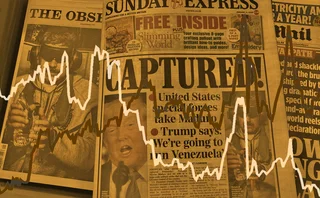
Pricing, capital and HFT: our biggest stories in 2015
Prudential rules and swaps reform unleash waves of change

It's not news that the banking industry is being forced to hold more capital and liquidity, or that regulation of the swaps market is being dramatically overhauled – but the effects of those twin reforms became far more visible over the past 12 months. Products and services were repriced, leaving dealers, clients and entire markets on shifting sands. In some cases, businesses became more costly; they are certainly far more complex.
Some of the outcomes were predicted well in advance – for example, that otherwise-identical interest rate swaps cleared at different central counterparties (CCPs) would have different prices, or that the increasing capital burden on bank trading businesses would see non-banks playing a bigger role in more products – but still had the capacity to surprise.
No-one expected it to take a matter of days for the price of 10-year receive-fixed swaps at CME and LCH.Clearnet to diverge by 2 basis points, for example. And few knew quite how dominant high-frequency traders had become in the interdealer market for US Treasuries.
These developments produced some of the year's biggest stories on Risk.net, and others were drawn from a similar pool of topics: derivatives pricing, trading book capital, market structure, and modelling. The list below shows the 10 biggest articles published during 2015, ranked by volume of traffic from all readers.
The year ahead is likely to be just as disorientating. Banks will have to start preparing for new trading book capital rules, margin requirements for non-cleared trades begin to phase in, and mandatory clearing finally arrives in Europe. The implications are clear; the precise outcomes are not.
1: Bank swap books suffer as CME-LCH basis explodes (May 15)
A trader emailed one of our journalists on May 12: "Have you guys had a look at the CME vs LCH basis market?" At that point, we had not; it became the biggest story of the year.
2: Basel Committee to consult on scrapping op risk modelling (October 6)
In an interview, the secretary-general of the Basel Committee revealed regulators were poised to end their 15-year experiment with the modelling of operational risk capital. Final proposals – originally due by year-end – were held up, as Risk.net also reported.
3: Client list reveals HFT dominance on BrokerTec (September 23)
US regulators spent months investigating an unprecedented intraday move in US Treasuries, ultimately pointing to a range of contributing factors, such as the increased market-making role of high-frequency traders. Publishing names and volumes for the first time, Risk.net showed just how dominant these firms have become on the leading interdealer platform.
4: The black art of FVA, part III: a $4 billion mistake? (April 2)
We added them up: 24 banks had taken a $6.2 billion loss when revaluing their derivatives books to incorporate funding costs and benefits arising from uncollateralised and partly collateralised trades. Some researchers now argue those figures are hugely exaggerated.
5: KVA: banks wrestle with the cost of capital (March 2)
Wildly complex, horribly divergent – but the practice of capital valuation adjustment made strides in 2015. In a Risk.net survey later in the year, some experts predicted banks will soon apply the charges to their books voluntarily.
6: Goldman hikes clearing fees by 75bp as leverage ratio bites (March 24)
Banks had been warning for months that users of clearing services would have to pay more. Goldman was one of the first to take the plunge.
7: Banks find huge capital jump in FRTB impact study (May 27)
How painful would the Fundamental review of the trading book be? Deloitte shared some client analysis with Risk.net before regulators had released their impact study results – it showed a sevenfold jump for rates trading desks under the draft standardised approach.
8: FVA accounting, risk management and collateral trading (January 30)
Risk.net has a loyal base of quant readers, but our Cutting Edge technical articles tend not to appear on site-wide most-read lists. This is the exception that proves the rule: Albanese, Andersen and Iabichino explain why the standard approach to funding valuation adjustment is wrong. The authors buttressed their argument later in the year.
9: JP Morgan warns on swaps clearing (February 24)
Lost in the depths of JP Morgan's investor day presentation was a stark warning about the future of the clearing business: "Current market economics are incompatible with capital rules in their current form for many of the leading clearing providers."
10: FRTB: the nightmare before Christmas (November 27)
It didn't arrive for Christmas, in the end, but the final throes of this ambitious three-year project remain nightmarish – with arguments about whether mean or median numbers should be used to gauge impact, the prospect of crude scaling factors during calibration, regulatory infighting and teeming questions about interpretation.
Only users who have a paid subscription or are part of a corporate subscription are able to print or copy content.
To access these options, along with all other subscription benefits, please contact info@risk.net or view our subscription options here: http://subscriptions.risk.net/subscribe
You are currently unable to print this content. Please contact info@risk.net to find out more.
You are currently unable to copy this content. Please contact info@risk.net to find out more.
Copyright Infopro Digital Limited. All rights reserved.
As outlined in our terms and conditions, https://www.infopro-digital.com/terms-and-conditions/subscriptions/ (point 2.4), printing is limited to a single copy.
If you would like to purchase additional rights please email info@risk.net
Copyright Infopro Digital Limited. All rights reserved.
You may share this content using our article tools. As outlined in our terms and conditions, https://www.infopro-digital.com/terms-and-conditions/subscriptions/ (clause 2.4), an Authorised User may only make one copy of the materials for their own personal use. You must also comply with the restrictions in clause 2.5.
If you would like to purchase additional rights please email info@risk.net
More on Markets
Brokers must shift HFT servers after China colocation ban
New exchange guidance drives rush for “proximity colo” in nearby data centres
LatAm FX carry trade shrugs off geopolitical fears
Clients in regional carry positions remain undeterred by US interventions, say dealers
S&P bull run drives interest in reset and lookback hedges
Variable strike put options proved popular alternative hedging format of 2025
US mutual funds slash short euro positions at record pace
Counterparty Radar: Pimco cut $4.6bn of EUR/USD puts in Q3 amid changing stance on dollar direction
Nomura hires new global eFX head
Mark McMillan to oversee e-trading and sales activities in newly created role
Trump’s LatAm gambit spurs FX hedging rush
Venezuela op boosts risk reversals as investors look to protect carry trades
One Trading brings 24/7 equity trading to Europe
Start-up exchange will launch perpetual futures Clob in Q1 after AFM nod
FXGO volumes surge despite fee switch-on
Dealers split on whether levy is behind volume increases across SDPs







